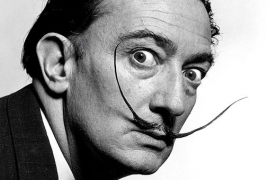Columbia Museum of Art features “Dalí’s Fantastical Fairy Tales” exhibit March 11, 2017 - 17:53 AMT PanARMENIAN.Net - The Columbia Museum of Art announces the major spring exhibition Salvador Dalí’s Fantastical Fairy Tales, on view March 11 through May 21, 2017, that explores the connections between art and literature through the artist’s signature playfulness, inventiveness, and fine draftsmanship. Featuring 36 colorful prints from The Dalí Museum, this whimsical exhibition showcases his illustrations for literary classics including Alice’s Adventures in Wonderland, Don Quixote, and the tales of Hans Christian Andersen, Art Daily said. Clever, quirky, and cutting-edge, Dalí is one of the great artists of the 20th century. He was the most famous and infamous proponent of surrealism, a literary and artistic movement that strove to liberate the subconscious mind from the oppression of rational thought. Championing the power of personal imagination, surrealists believed that dreams were as real as reality and that art created from visions could be as insightful as realism, if not more so. Dalí’s colorful personality, prodigious talent, love of publicity, and distinct brand of cheerful iconoclasm propelled him into the international spotlight. Original prints are a major part of Dalí’s body of work. The inherently populist medium lent itself perfectly to courting the masses, an activity in which he took great delight. True to form, his work in this medium ably demonstrates his hallmark irreverence, innovation, and versatility. Dalí approached the processes of printmaking in the same manner as all else in his life—unconstrained by the boundaries of convention. He experimented with an assortment of outlandish lithographic techniques to dramatic effect. Using a 15th-century musket, he fired bullets of color at point-blank range at the large stones, a method he dubbed “bulletism.” Running these stones through a press created an imprint he called “realism of quantified spots.” He dipped snails in ink so that they would leave trails as they crawled over the stone. He stuffed rhinoceros horns with French bread soaked in ink and crushed them onto the stone. He filled lightbulbs and eggs with ink, gravel, and pulverized sea urchin and threw or dropped them onto the stone. These unusual methods, coupled with Dalí’s figurative drawing, resulted in extraordinary illustrations that have enchanted readers and inspired artists for generations, Art Daily said. “Historically, critics and art historians have drawn a distinction between illustration and fine art, with illustrators being somehow inferior,” says Will South, CMA chief curator and creator of the exhibition. “This is why an artist like Norman Rockwell, for example, was for so long not taken seriously by museums. That discrimination has ended, and important artists such as Salvador Dalí are part of the reason why: Dalí saw nothing inferior at all about illustration. For him, it was another creative realm to explore, and explore it he did.” The incredible worlds conjured by authors such as Lewis Carroll, Miguel de Cervantes, and Hans Christian Andersen were ideal inspirations for Dalí, who deemed these books to be early examples of surrealism. In fact, in the 1930s, influential literary critic William Empson wrote: “Alice [in Wonderland] has, I understand, become a patron saint of the surrealists.” Published in 1969, Dalí's illustrations for Alice’s Adventures in Wonderland have become one of the most sought after Dalí suites of all time. These fantastical images reveal the vision of an artist who was one of the most sensational and creative minds of the 20th century. Published at the turn of the 17th century, Cervantes’ Don Quixote is considered one of the earliest novels and one of the most influential works of literature of all time. The story follows the adventures of the titular protagonist, a middle-aged man who, having lost his grip on reality, decides to become a knight to revive the lost tradition of chivalry. Full of import and nonsense, Don Quixote is a perfect match for Dalí’s sensibilities. Andersen’s fairy tales are among the most iconic stories in Western literature. Those who don’t know him by name are still likely to recognize featured tales such as The Ugly Duckling, The Little Mermaid, and The Snow Queen, upon which the blockbuster Disney film Frozen is based. To further establish the critical relationship between illustration and literature, the exhibition incorporates other editions of these literary classics courtesy of the Irvin Department of Rare Books and Special Collections at the University of South Carolina’s Thomas Cooper Library. “Dalí had many artistic heroes, from the classical Renaissance painter Raphael to the great modernist Picasso,” says South. “Having books in our exhibition from USC’s wonderful collection of rarities helps us to see some of the illustrators who came before Dalí and who, like him, worked to make dreamlike stories into visual images. Dalí benefitted from the work of his predecessors and found ways to add something new and different to the world of illustration.” The creative crew of the Public TV had chosen 13-year-old Malena as a participant of this year's contest. She called on others to also suspend their accounts over the companies’ failure to tackle hate speech. Penderecki was known for his film scores, including for William Friedkin’s “The Exorcist”, Stanley Kubrick’s “The Shining”. The festival made the news public on March 19, saying that “several options are considered in order to preserve its running” Partner news |